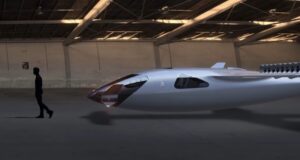Sirius Jet aims to ‘solve the environmental stigma of private air travel’, and has been developed by a pilot.
Alexey Popov’s cutting edge design can carry up to three passengers a maximum of 1,150 miles. A second model, the Sirius Millennium Jet, and produces no carbon emissions but with significantly greater range than electric aircraft can currently offer.
Hydrogen aviation is not a new concept, with the first successful flight taking place in 1957. Various iterations, attempts and prototypes have come along since. The Sirius blueprint is predominantly based on out-of-the-box technology, although a hydrogen-electric powertrain produced by BMW and Sauber F1 is completely novel.
Described as ‘the missing link’, this incorporates a ducted fan system which is used in multiple locations along both sets of wings. the front and midsection of the fuselage. The vertical takeoff and landing (VTOL) also has a unique flared tail. Combined, it is expected this will produce speeds of up to 323 MPH but only 60 decibels of volume. This is comparable to a conversation in a restaurant.












